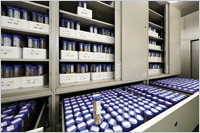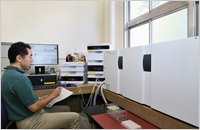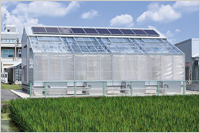Enlarge Image The barley germplasm collection including about 14,000 accessions
Enlarge Image Analytical equipment (LC-MS) for plant hormones
Enlarge Image Phytotron for genetically modified (GM) plants
Enlarge Image Guest house for visitors
Enlarge Image
 Okayama Travelogue
Okayama Travelogue
Okayama University Institute of Plant Science and Resources in Kurashiki: The oldest agricultural research institute in Japan
The Okayama University Institute of Plant Science and Resources (IPSR) is the oldest agricultural research institute in Japan. Established in 1914, the institute was originally known as the Ohara Institute for Agricultural Research—a privately owned entity named after the founder Magosaburo Ohara, a prominent entrepreneur and philanthropist of Kurashiki City, who established the institute for the welfare of farmers and promotion of agriculture in Japan.
The institute was transferred to Okayama University in 1952 and in 2010 the Ministry of Education, Sports, Culture and Technology (MEXT) approved the institute as a national 'Joint Usage/Research Center' in the fields of "plant genetic resources and plant stress science".
Research at the IPSR is conducted by independent groups led by principle investigators affiliated with two core areas of research and a research center:
Research Core for Plant Stress Science
Research Core for Future Crops
Barley and Wild Plant Resource Center
Researchers affiliated with IPSR also play an active role in education at the Okayama University Graduate School of Environmental and Life Science.
Amongst its wide ranging research activities, the IPSR is an international research center on barley. Reflecting its cutting edge research, in 2012 as a member of an international consortium, it succeeded in sequencing 98% of the barley genome and producing a high resolution assembly of the majority of barley genes in linear order—the results were published in Nature [1] with a summary of the findings in Okayama University e-Bulletin [2]. Furthermore, the IPSR has developed its own rice mutant lines in which researchers have found genes related to producing increased yields of the number of rice in rice-plant ears. Recently, IPSR researchers have identified the genes that determine the lengths of 'awns' of barley ears and genes related to cadmium absorption by rice, thereby showing that it is possible to significantly decrease the cadmium content of rice.
The institute is also conducting research on photosynthesis in plants. Researchers are focusing on finding new genes related to the maintenance of chloroplast and regulation of photo-inhibition, and mycorrhizal fungi of plants using mass spectroscopy based methods for highly precise/rapid identification methods. In this way, IPSR researchers are conducting research on various types of environmental stresses in plant bioresources.
Other research areas include research on the effect of salt and radiation on barley and wild plants in farmland affected by the 11 March 2011 earthquake and tsunami in Japan. In the case of barley, research is being conducted on breeding strains of barley resistant to salt and wet injury, which could be cultivated in the affected regions. In research related to wild plants, the emphasis is on wild weeds that grow in areas of Fukushima contaminated with radiocesium from the nuclear power station explosion in 2011. So far, three surveys (spring, summer, and autumn) were conducted in 2012 to measure the concentration of radiocesium in plants and soils. These experiments are expected to yield information for planning strategies for the management of farmland in the areas affected by radiation.
The IPSR welcomes students, researchers from all over the world. Please visit the website for more information about degree programs and international collaboration.
Further information
Institute of Plant Science and Resources, Okayama University: http://www.rib.okayama-u.ac.jp
Publications
[1] The International Barley Sequencing Consortium, "A physical, genetic and functional sequence assembly of the barley genome", Nature (2012); DOI: 10.1038/nature11543
[2] Okayama University e-Bulletin Research Highlights: http://www.okayama-u.ac.jp/user/kouhou/ebulletin/research_highlights/vol2/highlights_003.html





